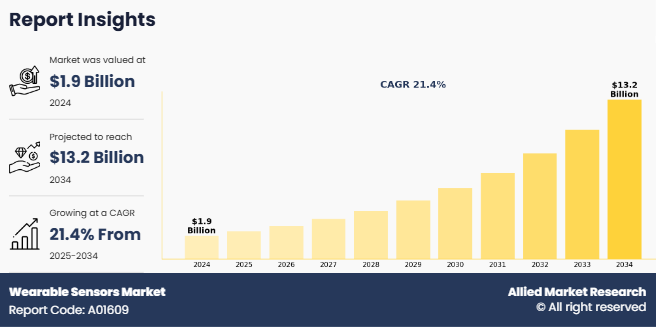According to Allied Market Research, titled “Wearable Sensors Market," The wearable sensors market size was valued at $1.9 billion in 2024, and is estimated to reach $13.2 billion by 2034, growing at a CAGR of 21.4% from 2025 to 2034.
Wearable sensors are compact, electronic devices integrated into or attached to the body—often through clothing or accessories that continuously monitor, collect, and transmit physiological or environmental data. These sensors enable real-time tracking of metrics such as heart rate, body temperature, motion sensors, and more, supporting applications in healthcare, fitness, sports, and human-computer interaction. One of the significant wearable sensors market trends is the advancements in sensor technology leading to the development of smaller, more energy-efficient devices capable of continuous health monitoring. In addition, there is growing trend toward the integration of Artificial Intelligence (AI) enabling personalized health insights and predictive analytics, enhancing the functionality of wearable devices. Furthermore, the rise of smart textiles and skin patches is expanding the form factors of wearable sensors, offering more discreet and comfortable options for users. These innovations are complemented by the increasing adoption of wearable sensors in remote patient monitoring and chronic disease management, facilitating real-time health tracking and early detection of health issues. As consumer demand for health and fitness tracking grows, the wearable sensors market is poised for continued expansion.
The global wearable sensors market is witnessing robust growth driven by convergence of miniaturized electronics, rise in health awareness and expanding ecosystem of connected devices. These sensors spanning accelerometers, gyroscopes, inertial and motion detectors, pressure sensors, and touch-based technologies form the backbone of modern wearables such as fitness trackers, smartwatches, smart glasses, medical patches, and industrial monitoring systems. Consumer applications dominate the market, accounting for over 70% of demand in 2023, fueled by rise in adoption of smart wristwear and bodywear devices. Simultaneously, healthcare and industrial sectors are rapidly Integrating wearable sensors for remote patient monitoring, worker safety, and real-time data analytics.
Furthermore, the wearable sensors market is benefiting from increased collaboration between technology providers, healthcare institutions, and research organizations aimed at enhancing device accuracy and clinical reliability. These partnerships are accelerating the development of sensors capable of monitoring complex biomarkers such as glucose levels, hydration, blood oxygen, and even stress indicators. Innovations in battery life, wireless charging, and energy harvesting are also playing a critical role in improving device usability and reducing the need for frequent maintenance or recharging. In parallel, user-friendly interfaces and mobile app integration are making wearable technologies more accessible to non-technical users, encouraging broader adoption across various age groups. As the global population continues to age, there is a growing need for unobtrusive monitoring tools that support independent living and long-term care, creating new market opportunities. With these advancements, wearable sensors are evolving from basic tracking tools into sophisticated health management systems that empower users to take control of their well-being.
Moreover, regulatory support and rising investments in digital health infrastructure are encouraging innovation and commercialization of next-generation wearable devices. The proliferation of IoT ecosystems and 5G connectivity is also enabling faster data transmission and improved device interoperability, making wearable sensors more integrated and efficient. Consumer interest in proactive and preventive healthcare, coupled with increasing awareness of lifestyle-related conditions, is further fueling market growth. Additionally, industries such as military, elder care, occupational safety, and personalized wellness are exploring new use cases for wearable sensors, signaling a broader and more diverse application landscape, propelling the wearable sensors market growth.
On the basis of application, the wristwear segment dominated the wearable sensors market share in 2024 and is expected to maintain its dominance in the upcoming years, owing to ease of use, multifunctionality, and continuous innovation in design and features. In addition, there is growing emphasis on health monitoring and fitness tracking, accelerating the adoption of wrist-worn devices. However, the neckwear segment is expected to experience the highest growth during the forecast period. This segment is experiencing increasing adoption in medical diagnostics, rising consumer interest in stylish health tech, and advancements in sensor miniaturization, as users seek discreet and comfortable wearable alternatives.
Region-wise, Asia-Pacific held the largest market share in 2024, exceeding 40%., fueled by high production capabilities, tech-savvy populations, and strong investments in smart manufacturing and healthcare. North America and Europe follow, supported by innovation hubs and rising chronic disease management needs. The market is expected to diversify further by 2034 with significant growth in medical-grade applications, AR/VR-enabled eyewear, and AI-integrated industrial wearables indicating a maturing ecosystem that is transitioning from fitness-focused consumer devices to advanced, multifunctional, cross-sectoral solutions.
Key findings of the study
- By Type, the accelerometers segment held the largest share in the wearable sensors market for 2024.
- By Application, the wristwear segment held the largest share in the wearable sensors market for 2024.
- By End-User, the consumer segment held the largest share in the wearable sensors market for 2024.
- Region-wise, Asia-Pacific held the largest market share in 2024. However, Europe is expected to witness the highest CAGR during the forecast period.
The key players profiled in the wearable sensors market analysis are STMicroelectronics, Panasonic Corporation, Infineon Technologies, Knowles Electronics, NXP Semiconductors, ROHM Semiconductor, TE Connectivity, MEMSIC, Analog Devices, and Murata. These players have adopted various strategies to increase their market penetration and strengthen their position in the wearable sensors industry.



